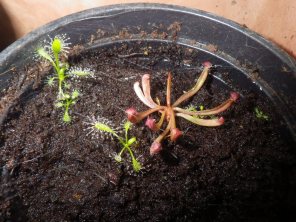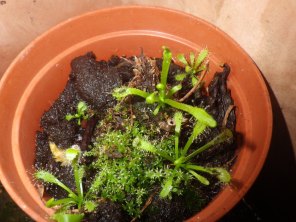When the limery was first built, we noticed that flies had begun to congregate in there and one of the builders suggested getting some carnivorous plants. I liked this idea – no unpleasant chemicals plus interesting specimens to care for.
In the past year I’ve had some successes and some failures – sadly not all of my plants have survived, but I have learned a lot, including what types of carnivores like the conditions available and the fact that slugs eat pitcher plants. It is because of this latter fact that my Sarracenia purpurea has a hole in the lower part of one of its 2015 pitchers (each pitcher in this species lasts a couple of years). As a result no liquid can accumulate in there, but it has attracted a resident – a spider. So I have an insectivore living inside an insectivore!
As you can see, it’s living perilously close to a Venus fly trap that would be perfectly capable of catching it. It has spun its web around all four of the plants in the water tray, but it must be very careful as it does this. This co-habitation has been going on for several weeks now and none of the organisms involved seem to be adversely affected, so I’m not interfering, although I have removed the Sarracenia seedling now as it was getting swamped by the web.
Looking round at my carnivores, it’s obvious how common co-habitation is… well, actually it’s really that sundews seem to be particularly keen to move in with any other carnivore except the Venus fly traps. What is particularly nice is that some of the young sundews must have arrived as hitch-hikers, because they are not species that I have bought.
In terms of doing their job, I’m pleased to report that fly capture is proceeding well – the pitcher plants (and spiders) catch big houseflies and the sundews catch the little black flies that seem to be associated with peppers growing in pots and whitefly that like the melons. I’m going to put the most rampant droopy Drosera dicotoma in a hanging basket, as its long leaves are getting rather out of hand on the window sill and it will then have maximum access to little flies.
And it looks like there may be more offspring to come – assuming Sarracenia is self-fertile, I am hoping for some seeds from this lovely specimen:
And there are likely to be yet more sundews as the Drosera capensis are flowering all over the place and forming seed pods
Now isn’t that so much more fun than fly sprays?































Pat
/ July 15, 2016Glad to see your carnivores are doing so well. And getting along with the new neighbor. Always interesting to observe nature up close. 🙂
LikeLike
The Snail of Happiness
/ July 15, 2016The spider obviously knows what its doing, although one incautious step and it will be dinner for the Venus fly trap!
LikeLike
nanacathy2
/ July 15, 2016Yes it is and I bet you spend ages watching it all happen!
LikeLike
The Snail of Happiness
/ July 15, 2016I have to be very strict with myself, otherwise I can find half an hour has slipped by whilst I sit watching them…
LikeLike
katechiconi
/ July 15, 2016That spider recognises a fellow predator! They work on a very similar basis: set the trap and then hold still for a good long time till the idiot prey gets stuck… But I think your plants are a good deal more decorative, and unlike the spiders here, they don’t bite people!
LikeLike
The Snail of Happiness
/ July 15, 2016I am very grateful for our lack of things bity and venomous here in Wales!
LikeLiked by 1 person
Ann
/ July 15, 2016Our venus fly traps were split up and planted in a large bowl, then put outside for the summer. “Thanks” said Mrs Blackbird, as she ferreted around in the moss, pulling off most of the shoots, in her quest for bugs. Thankfully they seem to be recovering.
Good idea about the sundews, might put some in the greenhouse. 🙂
LikeLike
The Snail of Happiness
/ July 15, 2016I recommend Drosera capensis, D. binata and D.dicotoma. If I get seeds I’ll send you some.
LikeLike